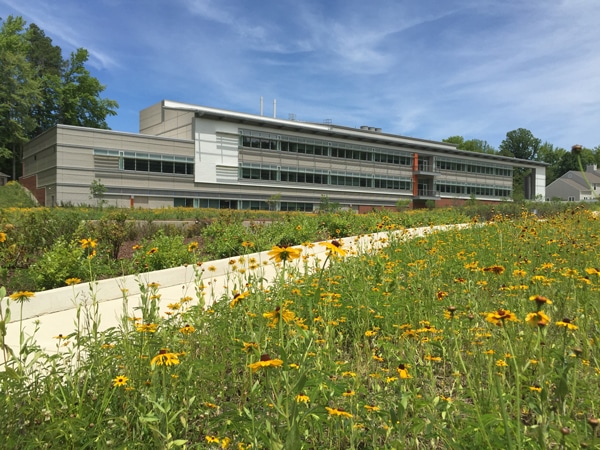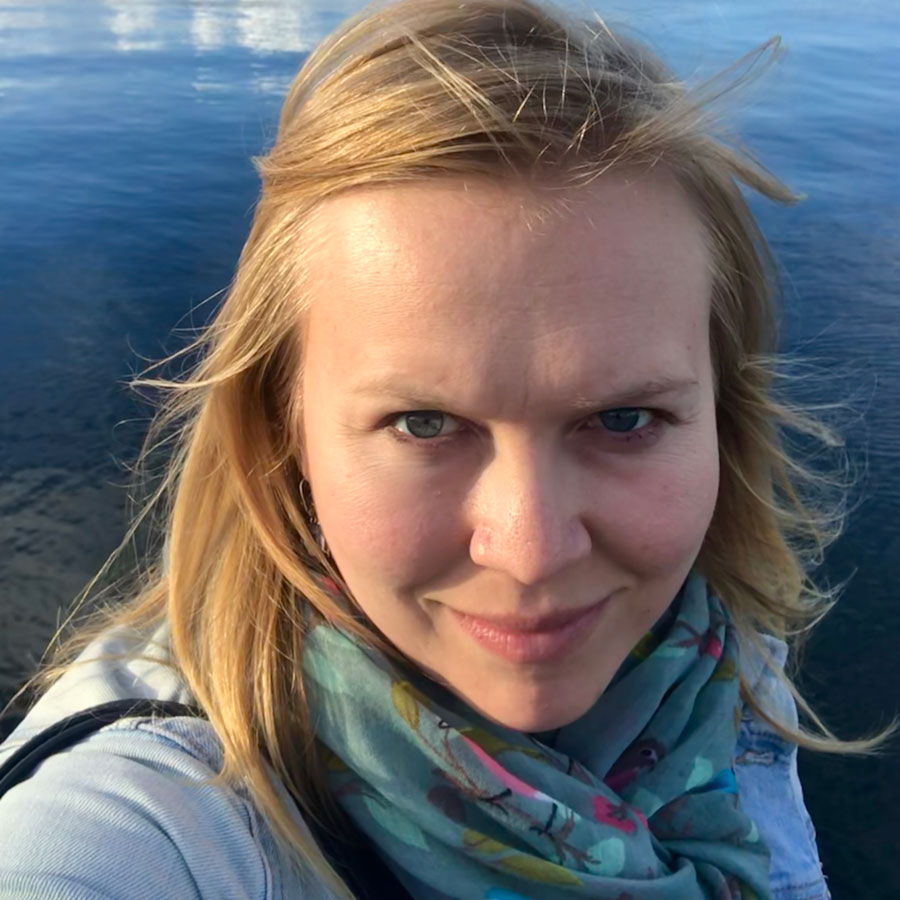A decade ago, many of the scientists at the Smithsonian Environmental Research Center (SERC) worked in rusting trailers scattered across a patch of cleared forest. The researchers at the site, located on the Chesapeake Bay in Edgewater, Maryland, conducted vital climate change experiments, but their facilities left much to be desired—environmentally, functionally, and aesthetically.
The nearly 200 scientists, technicians, and students needed a safe place to conduct their research, store their specimens, and work together. Today, they have that in the Mathias Laboratory, the Smithsonian Institution’s greenest building to date.
Within the lab, architect Howard Skoke, principal of EwingCole, set out to create an environment that fostered open communication among researchers. He accomplished that, in part through the creation of six “guilds” focused on areas such as marine studies or molecular ecology, giving scientists across 15 distinct laboratories spaces in which they can easily collaborate.
 The three-story facility is at the heart of what Skoke calls the “core research campus.” The lab is just one component of the SERC’s 2,650-acre Rhode River site, which is used for recreation, K-12 educational programs, and environmental research. Construction began in 2011 on the renovation and adaptive reuse of 23,000 square feet of existing facilities and the construction of 69,000 square feet of new laboratory and offices—all without interrupting the researchers who kept working at the site throughout the three-year building process.
The three-story facility is at the heart of what Skoke calls the “core research campus.” The lab is just one component of the SERC’s 2,650-acre Rhode River site, which is used for recreation, K-12 educational programs, and environmental research. Construction began in 2011 on the renovation and adaptive reuse of 23,000 square feet of existing facilities and the construction of 69,000 square feet of new laboratory and offices—all without interrupting the researchers who kept working at the site throughout the three-year building process.
The first Smithsonian project to achieve LEED Platinum status, it’s a showpiece for what is possible in the realm of research facility design. The certification is especially impressive given that laboratories require three to four times as much energy as other buildings, due to the energy-intensive work that takes place within their walls. The team slashed the project’s environmental footprint by maximizing daylighting and diving deep into renewables. A 352-kilowatt solar panel array provides water heating, covering 15% of the annual electricity usage. The 250 geothermal wells offer heat exchange, helping the building use 43% less energy than the baseline for a building of its type. EwingCole and its partners embraced the potential of geothermal, Skoke says, because it’s a fairly reliable source of clean energy, and one that is far more cost-efficient than other options would have been given the site topography.
The lab’s stewardship extends to water use; an interconnected system allows the facility to recycle 100% of its water. Greywater is treated on-site and then reused for fire protection, water-closet supply, and irrigation. Three cisterns, totaling 16,000 gallons, collect rainwater for the wetland, which filters stormwater and provides a habitat for native flora and fauna. These measures reduce the facility’s overall water consumption by 77%.
All told, the facility emits 37% less CO2 than a similar lab that doesn’t meet the LEED standards, and it saves 42% on energy costs. Moreover, 96% of the construction waste was recycled, and more than two-thirds of the materials were sourced regionally. The commitment to conservation is evident in the building’s atrium, where an online dashboard reports the real-time energy usage and water savings. It’s a constant reminder of the lab’s sustainable design and operation.

The Machine in the Garden, a series of wetland pools, runnels, weirs, and planting, provides an infrastructure for many beneficial processes beyond its aesthetic intention of creating a landscape scaled sculpture: eliminating potable water use for irrigation; managing stormwater; acting as receiving basin for fire protection ‘waste’ water; and providing opportunities for scientific experimentation and public education.
Outside the facility, scientists have access to a “living laboratory,” a space for them to conduct their work in a holistic environment, one that both informs the research and serves to educate the public about environmental issues, says landscape architect Kathy Poole, of Poole Design LLC. Managing stormwater on the site became an opportunity to showcase how wonderful landscapes can also accomplish important, infrastructural work, says Poole, who characterizes the series of stepped terraces and wetland pools that filter pollutants and regulate water flow, as a “machine in the garden.” The rehabilitated landscape covers the full extent of the geothermal field and provides opportunities for wildlife habitat as well as scientific experimentation. “It’s very rare I have the opportunity to express what’s going on inside the building on the outside,” she says. The Machine in the Garden connects building and landscape water systems into functional and aesthetic expression—an apt metaphor for the close collaboration between designers and client that enabled the project’s successes and its LEED Platinum accreditation.
The team shaped the design around both the lab’s current function and its future uses, Skoke says. “Throughout the planning and programming, we were always coming back to: What’s the immediate impact and the long-range impact?” That consideration ensured the lab’s long-term viability, noted SERC director Anson “Tuck” Hines: “The new lab provides us flexible space for future cutting-edge research,” he stated in a release. “[It] gives our scientists the ability to explore new territory in a more sustainable way.”


